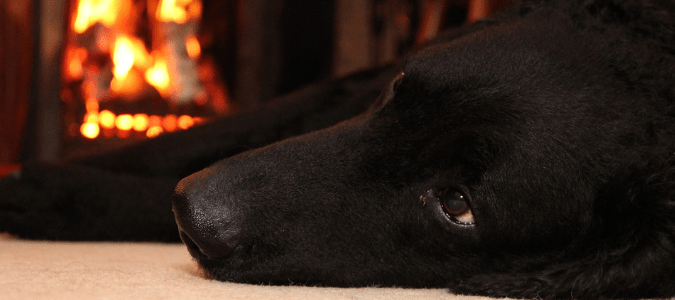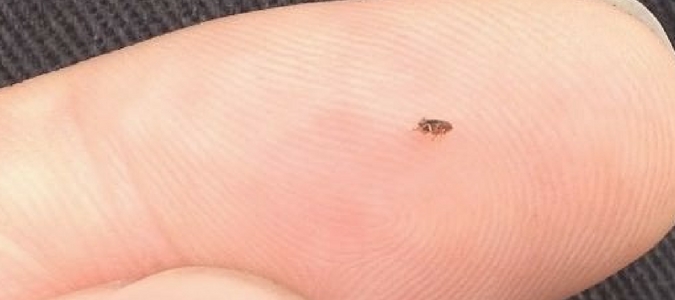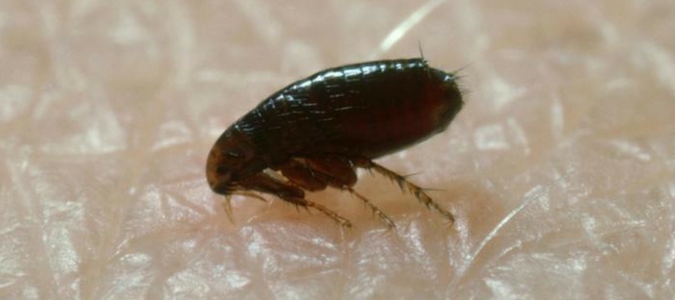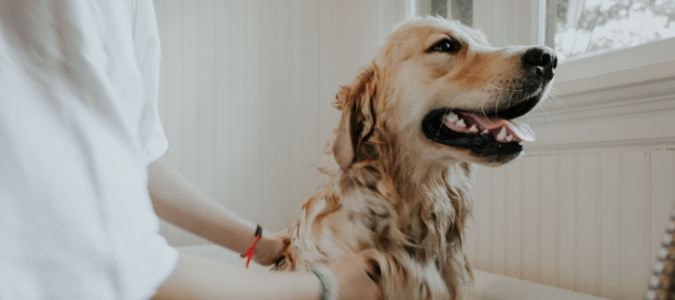
You couldn’t help yourself. You saw the cutest dog and decided she needed to become part of your household.
Six months later it happened. You woke up scratching.
Oh no.
Immediately you checked out your pup. And it was just as you feared: fleas.
The next day you got flea shampoo, thinking that would be that.
But a few days later, you woke up scratching again.
The shampoo wasn’t enough. Maybe you hadn’t killed them all the first time. Or maybe your furry family member was re-infesting the house with fleas from outside.
When the weather began getting colder, you thought perhaps you’d just wait them out. After all, wasn’t the cold supposed to kill fleas?
Not exactly.
Homeowners tend to underestimate fleas because we’ve been taught that they’re no big deal. Most of us assume that we can just head to the store and buy something and it will solve our problems like snapping our fingers.
Sometimes, though, it doesn’t, and finding the source of your flea problem starts with learning about these fascinating critters.
Let’s start by looking at the “cold weather” question. Does the cold kill them?
While it’s true that fleas enjoy living in the microenvironment around and within the home where humidity and temperature conditions are relatively high, they can actually survive through a vast range of temperatures in both summer and winter. In fact, when the temperature is harsh and unfavorable, fleas in early stages of development (especially the pupa stage) simply become dormant and wait it out.
What else should you learn about fleas if you are worried you might have an infestation? We’ll answer many other common questions about fleas below.
At What Temperature Do Fleas Die Inside?
We hate to be the bearer of bad news, but here’s the answer to the question many homeowners have: There is no “wrong” temperature for fleas.
We’ll say it straight out: fleas do not die in the winter due to cold. As mentioned above, both immature stages and adult fleas can survive through extreme temperatures.
You’re not going to freeze them away.
While we’re at it, we might as well clear up some other common misconceptions about fleas.
Think fleas cannot infest an empty home? Unfortunately, they will not leave or die when you leave a space vacant for a long time in the hope that the fleas will starve. Immature stages will simply go into dormancy waiting for a suitable host to come by.
If you temporarily relocate your pet, will fleas go away? Unfortunately, these pests will not leave just because you remove a dog or cat from the flea-infested house. Immature stages will continue surviving in the environment, while adult fleas will move on to alternative hosts.
Getting rid of fleas should, therefore, be a well-executed process that targets the various stages in the life cycle of the flea. We’ll get to that later.
First, though, let’s address the question everyone always wants to know about the flea life cycle.
How Fast Do Flea Eggs Hatch?
More than 15 different species of fleas have been shown to affect domestic pets. As you might imagine, this means that there’s quite a bit of diversity in the life cycle of fleas and how long various parts of it take.
Depending on both the species in question and various environmental circumstances, the entire flea life cycle may take anything between two weeks and two years.
That being said, some things are relatively consistent.
All fleas begin as eggs. A single adult female flea can produce as many as 50 eggs per day. Adult females must get a blood meal for them to reproduce. After ingesting their first blood meal, females begin laying eggs within 24 hours.
Typically, it takes about 12 days for these eggs to hatch.
So, that’s your timeline. If your pet gets infested, you’ve got around two weeks before the next generation comes along and you’ve got even more fleas to deal with.
What Does the Rest of a Flea’s Life Cycle Look Like?
As with many other pests, with fleas there are four distinct phases which comprise the life cycle.
Stage 1: Egg
The life of a flea begins at the egg stage. You probably knew that already.
A female flea will lay tiny white eggs on the feathers, hair or habitat of the host. These eggs fall off the host onto the host’s bedding, the ground, the floor or furniture.
After about 12 days, the eggs hatch into worm-like larva.
Stage 2: Larvae
A single flea larva measures almost a tenth of an inch in length. These creatures feed on organic debris, including feces from the adult flea, flea eggshells and other flea larvae.
Flea larvae mostly develop outdoors in cool, dark, shady places where pets play and rest. They may also develop indoors in dark, undisturbed environments such as under furniture, along baseboards and in thick carpets.
Stage 3: Pupa
After about another 12 days, the larva rolls into whitish cocoons and become pupates. Flea pupas may be found under furniture, in the soil, in carpets, on vegetation and on animal beddings.
Fleas can remain in the pupa stage for up to five weeks, though typically they emerge from their cocoons as adults by day 13 and immediately begin looking for blood.
Stage 4: Adults
The transition into adult fleas is usually triggered by a sign that a potential host is nearby (e.g. vibrations caused by hosts as they move around).
This is why returning to an abandoned house may expose you to a sudden attack by numerous fleas.
When Are Fleas The Worst?
Just because extreme weather won’t kill fleas doesn’t mean that certain times of the year aren’t better or worse. Flea populations are highest during summer and fall when the conditions are warm and humid, similar to peak season for many other common household pests. You’re likely to see the most fleas in August and September.
Beyond temperatures, fleas tend to live and breed more heavily around where the pet sleeps. These creatures will also attack people who come close to the heavily infested sleeping areas, so if you sleep with your pet—or close by—watch out!
Something important to note is that when conducive conditions prevail, you only need to bring a single adult flea into your home to start an infestation. Since a single flea can lay up to 50 eggs daily, your home could be crawling with fleas within a few months.
When Do Fleas Go Away?
Another common question is about when fleas are less prevalent. The answer to that question depends on exactly what you mean.
Outside of the summer and fall, fleas tend to be less active, but that doesn’t mean they’re totally gone. Your dog or cat can still get fleas in winter or spring—it’s just less likely.
What if you’re already dealing with an infestation?
Well, fleas are certainly not going to go away on their own. You need to take steps to get rid of them.
Unfortunately, fleas are difficult to eradicate because they:
- Are physically resilient
- Can find alternative hosts
- Can multiply rapidly
- Are able to live outside the host in the environment around the home
So, how do you manage and quell a flea infestation?
If you are not thorough, you will find yourself trapped in a perpetual battle in which fleas keep coming back in waves—over and over and over again.
What steps should you take before calling in a professional?
Treat Your Pet
This step focuses on killing the fleas on your dog or cat. All household pets in flea-infested homes should be treated—even if they do not display any signs of flea infestation. Treating the animal may be accomplished using a combination of any of the following methods.
Spray And Spot-On Products
These topical products are applied on to the pet’s body as a preventative. The solutions kill the flea before it bites the pet. In addition to direct flea-killing, these products are packed with extra anti-flea properties. For instance, some of the products attract fleas onto the pet as it moves around. The fleas are then killed when they come into contact with the chemical. Others contain flea-repellant components.
Pills And Oral Medications
Once ingested, these medications enter the animal’s bloodstream. When fleas suck blood from your pet, they die. These medications are particularly effective for indoor pets that rarely leave the house. Some medications may also have components to counter any emergent flea-bite allergies.
Combing, Shampooing And Pet Grooming
Grooming, shampooing and combing using a flea comb manually remove parasites from the pet’s body. When done frequently, this method is effective in preventing flea infestation among pets.
Treating flea-infested pets should be done under the guidance of a veterinarian or animal specialist. To ensure that pets remain free of fleas, the above anti-flea measures should be performed routinely—especially for outdoor pets that are continually exposed to possible sources of fleas.
Treat Your Environment
After every pet has been treated, it’s time to treat the house and the surrounding environment. Household flea treatments can help do the trick when you are treating your home for fleas. In treating the environment, your goal is to kill not just adult fleas, but also eggs, larva and pupates.
Any Time Of Year, Fleas Are No Match For ABC
Contrary to popular belief, fleas can cause quite a disruption in your household, making your pets miserable and making you uncomfortable in just the place you rely on to relax and unwind after a busy day. ABC Home & Commercial Services uses methods are aimed at removing the infestation quickly and thoroughly, while also using the least invasive treatments possible to protect both you and the environment. Once we remove the pests, we will work with you to make changes to your property to make it less friendly to fleas in the future.




